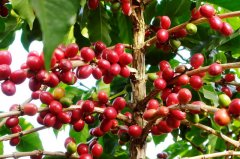The concept of Coffee roasting study on roasting Technology of Coffee roasting tendency in various countries

For professional baristas, please follow the coffee workshop (Wechat official account cafe_style)
Open classification: coffee technology
Roasting is the source of coffee flavor, roasting raw beans is called roasting, raw beans can not be drunk without baking, roasted coffee beans have determined 80% of the taste of coffee, the roasting process is very tricky, the fire is too strong, the fire is too weak, then the inner ripe overcooked. Coffee beans are roasted internally and externally, and the key point is to control the heat. Raw coffee beans themselves do not have any aroma of coffee, only after fried, can you smell the strong aroma of coffee. So the roasting of coffee beans is the transformation process of the internal components of coffee beans, only after roasting to produce ingredients that can release the aroma of coffee, we can smell the aroma of coffee. But in the roasting process of coffee beans, the transformation of ingredients is very complex, after all, coffee beans are organic matter, so the transformation of this component is very complex, and the modern knowledge of organic chemistry can not fully understand.
Basic information module
English name: coffee roasting foreign name: SPCIAITYCOFFEE
Baking time: 5-25 minutes baking classification: baking in shallow baking city baking deep baking
Countries of transmission: Japan, United States, France: green, yellow, brown
Catalogue
1 concept
2 the tendency of baking in various countries
3 study on roasting technology of coffee
4 the eight stages of baking
Concept / coffee roasting
Roasting is about the boiling of coffee beans, creating the unique color (amber), flavor and aroma of coffee. Roasting turns the light green raw coffee beans into the tea-brown coffee beans we are familiar with. High-standard fried roasting refers to the ingenious expression of the aroma, sour and bitter taste of raw coffee beans.
Roasting tendency / Coffee roasting in various countries
Cities all over the world have their preferred baking tendency.
In Tokyo, micro-deep medium baking is more popular, but slowly it also tends to deep baking. As for Kansai, deep baking has been popular in the past.
New York, as its name suggests, generally prefers urban baking, but because the city is inhabited by different races of people, it also sells coffee beans with different roasting degrees, and the variety is also quite rich.
Vienna prefers deep baking. Even as the name suggests, the French prefer French baking, while Italians often use Italian baking.
Coffee roasting
Coffee roasting atlas?
However, in recent years, Italian baking (the most commonly used deep roasting in Brazil and Italy) has been widely used in Europe and the United States, and the coffee made by steam pressurizer is still popular.
Deep roasting of Ethiopian coffee beans would be a waste. Because that would lose the unique characteristics of this coffee. Black roasting of Yauco and Kona coffee beans is also bad, because you will lose the classical flavor you pursue when you buy it.
When some coffee beans are roasted black, new and interesting qualities will be derived. Mexican coffee beans produce an interesting sweetness when roasted in black.
Guatemala Antigua coffee beans seem to retain their sour and fruity flavor when they are deeply roasted, which is difficult for other coffees.
Sumatran coffee beans are usually full-grained, but are below medium acidity, lose acidity when roasted deeper, and easily turn into sugar paste.
Generally speaking, the darker the baking, the lower the quality. Deeper roasting means losing most of the flavor of the coffee beans.
Study on coffee roasting technology / coffee roasting
A series of chemical changes occur in the process of baking. After about 15 minutes of baking, green
Coffee beans lose humidity, turn yellow, and then burst, just like popcorn. After this process, the coffee beans will double in size and begin to show a light brown after stir-frying. After this stage is completed (after about 8 minutes of baking), the calories will be reduced. The color of the coffee soon changed to dark. When the default baking degree is reached, cold air can be used to stop baking to achieve rapid cooling.
one
1 atlas
Roasting is roughly divided into light (IIGHT), medium (MEDIUM), deep (DARK) and very deep (VERYDARK) roasting, light roasted coffee beans: will have a strong smell, very crisp, high acidity is the main flavor and light mellow. Medium-roasted coffee beans: have a strong mellow, but also retain most of the acidity. Deep-roasted coffee beans: there are traces of grease on the surface, and the acidity is replaced by a slight bitterness, resulting in a pungent taste. Very dark roasted coffee beans: the color is black, because the oil to penetrate to the surface, with a bitter taste of carbon ash, mellow significantly reduced. In fact, roasting coffee is a way of processing food. The roasting of professional coffee is the personal expression of the roaster. The biggest problem with first exposure to professional coffee (SPCIAITYCOFFEE) is the name of the degree of baking. For example, CITY, FUIICITY, FRENCH, ESPRESSO, etc., all produce different baking colors because of the different baking machines and producing areas. In addition, some roasting levels are named after mixed coffee: for example, ESPRESSO is a coffee with a specific roasting degree for making ESPRESSO, and even if the color looks the same, it may have a completely different flavor. Therefore, the selection of the type of beans, baking temperature and baking method, and the length of baking time are the main factors that determine the final flavor.
Eight stages of roasting / coffee roasting
The roasting method of professional coffee is usually divided into the following eight stages.
1. Very shallow baking (LIGHTRoast):
The degree of baking; very shallow baking, also known as shallow baking.
The lightest roasting degree of all roasting stages, the surface of the coffee beans is a light cinnamon color, its taste and aroma are insufficient, this state is almost undrinkable. It is generally used for testing and seldom for tasting.
2. Shallow baking (CINNAMONRoast):
Degree of baking; shallow baking, also known as cinnamon baking.
The general baking degree, showing cinnamon color on the appearance, the smell of green has been removed, the aroma is OK, and the acidity is strong, which is a common roasting degree of American coffee.
3. Micro baking (MEDIUMRoast):
Baking degree; moderate baking, also known as micro baking.
Medium baking heat and light baking are both American, in addition to sour taste, bitterness also appears, the taste is good. It has moderate aroma, acidity and mellowness, and is often used in the baking of mixed coffee.
4. Medium baking (HIGHRoast):
Baking degree; moderate micro-deep baking, also known as concentration baking.
Belongs to the moderate micro-deep baking, the baking degree is slightly stronger than the slight medium baking, the surface has appeared a little thick brown, the bitterness also becomes stronger. Coffee tastes sour and bitter, with good aroma and flavor, and is most often loved by people in Japan and Central Europe. (blue Mountain Coffee)
5. Medium and deep baking (CITYRoast):
Baking degree; medium-deep baking, also known as urban baking.
The most standard degree of roasting, bitterness and acidity are balanced and are often used in French coffee. (Brazil, Colombia)
6. Deep baking (FULL-CITYRoast):
Baking degree; micro-depth baking, also known as deep city baking.
The baking degree is slightly stronger than the medium depth, the color becomes quite dark, and the bitter taste is stronger than the sour taste. It belongs to the Central and South American baking method, which is very suitable for preparing all kinds of iced coffee.
7. Very Deep Baking (FrenchRoast):
Degree of baking; deep baking, also known as French baking.
Also known as French or European baking, belongs to deep baking, the color is thick brown with black, sour taste can not be felt, especially in Europe, France is the most popular, because the fat has infiltrated to the surface, with a unique flavor, very suitable for coffee Oulei, Viennese coffee.
8. Very Deep Baking (ItalianRoast):
Degree of baking; very deep baking, also known as Italian baking.
Also known as Italian baking, baking degree before carbonization, there is a scorched taste, mainly popular in Latin countries, suitable for fast coffee and cappuccino. Most of them are used in Espresso coffee series.
Baking depth meter
Baking depth appearance baking stage
Very shallow baking LIGHT
Light brown
The first explosion is over, about 205 degrees.
Shallow baking CINNAMON
Yellowish brown
Before and after the start of the first explosion, it was 205 degrees at 195m.
Medium baking / micro baking MEDIUM
Brown
About 205 to 215 degrees
Medium and deep baking / city baking CITY
Reddish brown
About 215 to 225 degrees
Deep city baking FULLCITY
Dark brown * dotted oil
Before the start of the second explosion, it was about 225muri 230 degrees.
ESPRESSO baking
Dark brown * oily on the surface
About 230 to 235 degrees
Italian baking Italian
Dark brown * the surface is oily
About 235 to 240 degrees
French baked French
Close to the black surface and greasy
Above 240 degrees
Important Notice :
前街咖啡 FrontStreet Coffee has moved to new addredd:
FrontStreet Coffee Address: 315,Donghua East Road,GuangZhou
Tel:020 38364473
- Prev

Mechanical principle of coffee roaster: the structure of coffee roaster and the characteristics of its components
For the exchange of professional baristas, please follow the coffee workshop (Wechat official account cafe_style). Next, we will explain the structure of our coffee roaster and the characteristics of each component. There may be some difficulties for the people who have just come into contact. I hope you can try your best to understand! The construction of the coffee roaster looks very simple. It is true that electrical machine control or gas control is not very difficult to control.
- Next

The 7 Most Common Iced Coffee Practices of the Year How to Make an Authentic Iced Coffee
Professional barista communication Please pay attention to coffee workshop (Weixin Official Accounts cafe_style) Cold brewing coffee: coffee is soaked in lukewarm (i.e. cold or room temperature) water for a period of time, usually 8-24 hours. The ratio of coffee to water is usually (but not always) intended to produce a concentrate for dilution with ice and/or milk at the time of consumption. Japanese iced coffee: sometimes also known as quick coffee
Related
- Beginners will see the "Coffee pull flower" guide!
- What is the difference between ice blog purified milk and ordinary milk coffee?
- Why is the Philippines the largest producer of crops in Liberia?
- For coffee extraction, should the fine powder be retained?
- How does extracted espresso fill pressed powder? How much strength does it take to press the powder?
- How to make jasmine cold extract coffee? Is the jasmine + latte good?
- Will this little toy really make the coffee taste better? How does Lily Drip affect coffee extraction?
- Will the action of slapping the filter cup also affect coffee extraction?
- What's the difference between powder-to-water ratio and powder-to-liquid ratio?
- What is the Ethiopian local species? What does it have to do with Heirloom native species?

